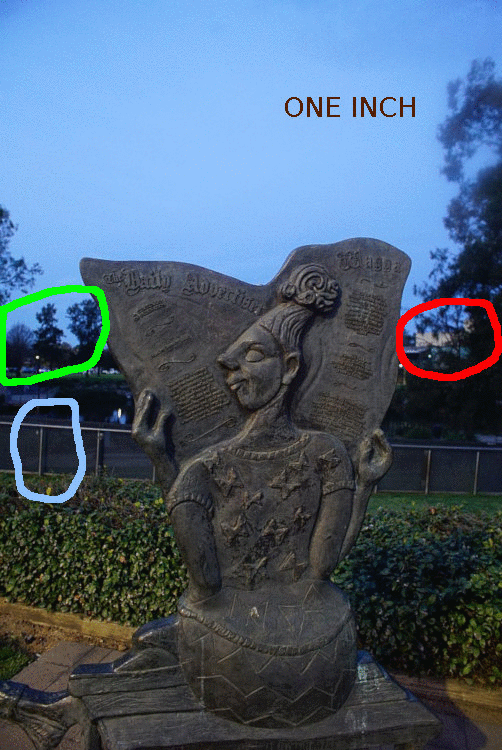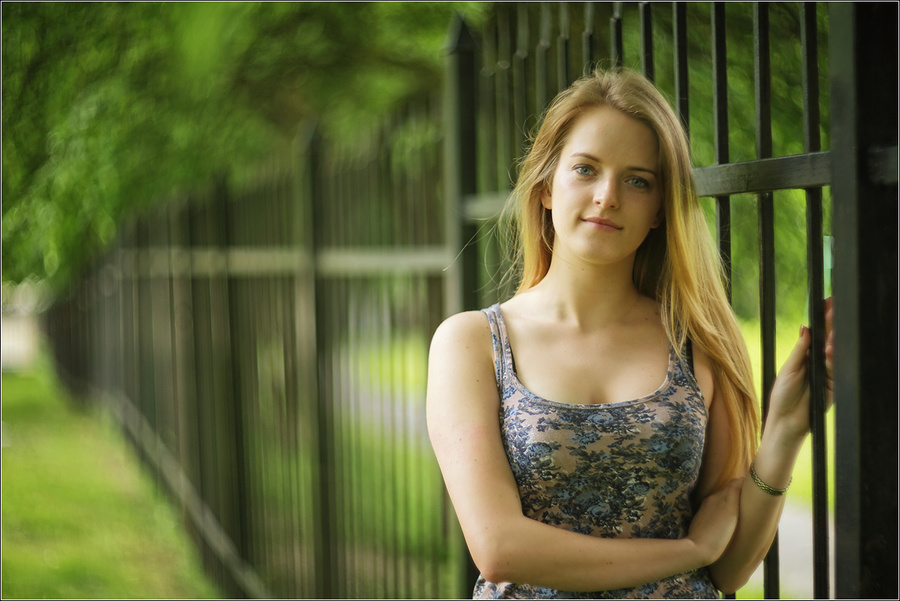-
Posts
1,151 -
Joined
-
Last visited
Content Type
Profiles
Forums
Articles
Posts posted by tupp
-
-
14 hours ago, noone said:
if someone really went to the trouble of trying for an EXACT match they would need to take into account everything including each individual lenses characteristics, and that would be almost as difficult to do with two M43 lenses of the same focal length as it would with a Pentax Q and a Mamiya 7 with a digital back (assuming you can find lenses to match).
So, if there is no way to get a close enough match in focal length for an equivalency test, how can any of the equivalency tests made so far be accepted as valid?
Actually, there are a lot of 16 and Super 16 prime lenses. Start with that format as the smaller camera. There are also plenty of 8"x10" lenses. It shouldn't be too difficult to use the formula behind the equivalency principle to calculate a close enough match with lenses for those two formats. A little cropping of one of the images is okay, but a zoom lens is not okay.
14 hours ago, noone said:I am satisfied the photos I posted show enough similarity to prove my point and just to satisfy myself I DID test with my Sony Zeiss 55 1.8 VS the RX100 iv Sony Zeiss lens and it is as i suspected a closer match still.....now since it is not an EXACT match and was also just a quick and dirty comparison, there is zero point posting because you would just say it is different.
Well, everyone has a right to their view. You evidently don't see the stark differences that I can see with just a glance at the full frame and 1-inch images.
Perhaps another comparison method of the two images would make the differences more apparent. Here is a gif of the two equivalent images alternately flashed at one-second intervals:

Do you not see in the area outlined in red how the distant white building exhibits sharp edges in the 1-inch image, while it is much softer in the full frame image?
Likewise, inside the green outline, do you not see how the distant trees are significantly blurry in the FF image, yet we can see their individual branches in the 1-inch image?
Closer to the camera, within the blue outline do you not notice how the vertical supports on the fence are softer in the FF image and sharper in the 1-inch image?
From your description, I wasn't completely sure which image came from which camera, so please correct me if I got the format labels wrong. Regardless, there is a substantial difference in the look and DOF of the two images.
14 hours ago, noone said:Feel free to set things up to match theoretically lenses of two (or more) different formats but include a couple of lenses for each format used....If you do that, I am sure the photos would be the same, if you are not, then maybe you should disprove it...
I actually offered to collaborate on an equivalency comparison with an EOSHD poster who is a staunch proponent of the equivalency principle and who happens to reside in my town. The equivalency poster refused my offer.
I would not do such a test without an equivalency supporter present to oversee and certify the matching of the DOF. If I did the test alone, without such certification and if the results showed a dramatic difference in look/DOF, folks would just claim that I did something wrong or that I intentionally manipulated the images. Several times in this forum I have pointed out prominent discrepancies in DOF/equivalency tests and those differences were dismissed as unimportant or ignored as unavoidable testing "inaccuracies." I am not going to go through all the effort to do a proper comparison just to have the findings rejected outright.
14 hours ago, noone said:Lastly regards Dr Caldwell,
"Do the experiment properly and you'll find that the perspective is the same. Surely you must have heard countless times before that perspective depends only on the subject distance. This is a truth that you shouldn't ignore. More precisely, perspective depends on the distance from the subject to the entrance pupil of the lens. For this reason, the entrance pupil is sometimes called the center of perspective. "
I disagreed with you in that thread and I disagree with you in this one hence why this is pointless now.
I never disagreed with Caldwell regarding perspective. Certainly, perspective is determined by the distance of the camera/observer from the subject, but there are exceptions to that rule, depending on how one defines "perspective."
However, perspective has little to do with the question of whether different sized formats give contrasting looks or exhibit differing DOF.
By the way, Caldwell agreed that there is more to DOF than the the factors/variables found in the DOF formula (which is the basis for the equivalency principle).
-
21 hours ago, BTM_Pix said:
Having to have the FF at f4 because the APS-C had to be at f2.8 and the MFT with the SB could be f2 is not doing the FF any favours.
It's probably best to first set the desired DOF on the smaller format, then match that DOF range on the larger format by eye with a large monitor and/or digital zoom.
In addition, it is important to start out with a set-up that gives all of the information on what is happening with the DOF/focus, visible continually from front to back, both inside and outside of the DOF range. An ideal arrangement might be next to a receding fence, like this:

Note how the vertical rungs in the fence give a good idea of how/where the rear limit of the DOF range is delineated. It probably would show a more precise DOF limit delineation if the horizontal rung behind the subject's head was visible. Also, this set-up could be improved by panning the camera right and/or pulling the camera back to reveal how the front limit of the DOF is delineated on the fence. Additionally, if there were closer trees or other landscaping visible through the fence, that could add extra information on how background objects are rendered/resolved.
22 hours ago, BTM_Pix said:Matching the focal lengths also make it a challenge without using a zoom as well of course as at least they maintain the same contrast and colour for each camera.
A small bit of cropping on one of the images probably wouldn't ruin such a test, but using a zoom would.
22 hours ago, BTM_Pix said:I'm trying to think about which set of cameras and primes that could be used for be a totally accurate test if someone wanted to do it properly and its a tricky ask to get exact matches.
Using two cameras of dramatically differing formats might exhibit a more conspicuous difference in look/DOF that might help overcome some of the minor inaccuracies afflicting tests with camera formats that are close in size.
-
-
On 9/12/2020 at 11:03 AM, BTM_Pix said:
FWIW, I did a very quick basic comparison between MFT, APS-C and FF at a couple of focal lengths a few years ago on here...
Thank you for doing that comparison!
On 9/12/2020 at 11:03 AM, BTM_Pix said:... and the differences in those specific limited instances with zoom lenses to create the correct equivalent focal lengths were marginal.
... but, as you state, there were differences, nonetheless, even though zoom lenses were utilized for the test. The differences that I see are significant.
In addition, the comparison suffers the same maladies that afflict all equivalency tests so far. The front and and rear limits to the DOF are not clearly shown. Also, not visible is the focus fall-off outside of the DOF range.
Furthermore, the DOF is rather deep. The visual benefits of larger formats are more readily revealed by a shallower DOF.
On 9/12/2020 at 11:08 AM, noone said:IF I spent ages and ages, setting it up and trying for an exact match, the photos WOULD look extremely close (24 at f4.8 vs 8.8 at 1.8) even with this apples to fish comparison.
I don't think that they would match too much more closely than what is shown -- not with two primes and not with a shallower DOF and not with clearly showing the foreground and background limits of the DOF. Also, there seem to be some problems with the test that make it inconclusive.
The images certainly wouldn't match if two dramatically different sized formats were compared, such as Super 16 and 8"x10".
On 9/12/2020 at 11:08 AM, noone said:Again though why on Earth would I want to?
Perhaps one would do so to prove one's point. So, far I haven't seen a single equivalency test that actually demonstrates that two prime lenses made for different formats can match.
On 9/12/2020 at 11:08 AM, noone said:Given I used a more than thirty year old prime against a much more modern fixed lens zoom on a tiny 1 inch sensor camera and to me, the photos are pretty similar (with errors down to me), I think I proved my point.
Again, thank you for doing the test, but, unfortunately, the differences between the images are prominent, and the test suffers from many the same problems inherent in every DOF/equivalency comparison so far.
On 9/12/2020 at 11:08 AM, noone said:Lastly, if you compared different M43 lenses against each other at the same focal length and/or different M43 cameras the look would not be the EXACT same as no two of ANYTHING will be exactly the same.
The images from two different M4/3 primes of the same focal length would probably not look as different as the images shown in the test.
To do a proper test, a lot more of the variables have to be controlled, and crucial data cannot be obscured (as seems to be the case in most such DOF tests). It's not easy to wrangle all of those elements, but nothing will be conclusive until somebody does it correctly.
In the meantime, here is footage shot on Zev Hoover's 8"x10", reflective DOF adaper, and here's a video by our own @Gonzalo Ezcurra testing the focus and DOF on his 14"x14" MiniCyclops DOF adapter. Neither clips are making a DOF comparison with another format, but note how some of Gonzalo's shots intentionally show the foreground that is outside of the DOF range.
I would like to see someone use M4/3 to match the looks in the above videos.
On 9/12/2020 at 3:30 PM, noone said:since people would argue with the bloke who designed the Metabones speedbooster as well as one of the best lenses ever (Coastal Optics 60mm f4),there is zero point in a non entity like me trying any further.
Not sure how someone arguing with Brian Caldwell is relevant to the points made in this thread, but us "non-entities" should hold our ground!
-
By the way, It's good that you did not use two formats that "contiguous" in size -- most tests are APS-C vs. FF, or M4/3 vs. APS-C. The differences between such similarly sized formats is slight.
However, if you do the same test between Super 16 and 8"x10", the differences in DOF roll-off and the in general look of different sized formats is readily apparent.
-
Thank you for making this comparison.
All three of the images differ from each other perceptibly, despite detail missing in the black background areas and despite the fact that the "given" DOF is way too deep for valid test. It's best to start out with a longer focal length and show detail that continually runs from in front of the subject to a far distance in the background.
Also, I have never seen a equivalency test that shows how the foreground limit of the DOF -- that's very important in an equivalency test. I think that I have only once seen an equivalency test that actually showed the location of the background limit of the DOF.
In addition, is there a zoom lens on the 1 inch camera? Zoom lenses handle focal length differently from primes.
-
13 hours ago, noone said:
A 50mm lens is a 50mm lens no matter the format
Not really. A 50mm lens for Super 16mm usually has to pack more lines of resolution into a smaller area than, say, a 50mm lens made for medium format. That difference in lines-per-mm makes a difference in look and in sharpness (which is involved in DOF).
-
1 hour ago, noone said:
If you took three photos.. 50mm f2 on M43, 100mm f2 on FF and 100mm f4 on FF (all things being equal) first and third will look the same second will not.
Strongly disagree here. Even if #1 and #3 match according to the "equivalence principle," they won't look the same.
The DOF on a Super 16mm camera can be made to "mathematically" match the DOF on an 8"x10" camera, but they will not look the same. Furthermore, in the same scenario, the rate and manner in which the DOF "rolls off" will differ between those two different formats.
-
4 hours ago, Amazeballs said:
I think I foind extremly cheap and efficient solution. This device called - a paper bag 😆
Someone suggest white plastic bags early in the thread.
3 hours ago, BenEricson said:I think you'll likely kill nearly all of the output with the diffusers people have been suggesting...
Early in the thread, someone suggested regular diffusion gels, which come in a variety of grades and light transmission rates.
3 hours ago, Amazeballs said:Sadly those 3x3 inches shower cap diffusors will be too small for my light which is about 3x5 in size, otherwise a nice solution.
If you are trying to make the light softer, a 3x5 diffuser on a 3x5 fixture won't help.
-
3 hours ago, Antoin e said:
Hey yall, so my sdi input on the BMVA broke after a small fall
Very sorry to hear about that. Did it fall off of a car mount? 😉
-
3 hours ago, Márcio Kabke Pinheiro said:
But the one in the link is for the E-M5 / E-M1 line, no? The battery is larger than E-m10's.
Oops! You're correct! I linked the wrong dummy battery!
Unfortunately, I can't change the link.
Here is the dummy battery (and USB boost converter/adapter) for the E-M10 models.
Thanks!
-
Again, why do you want to put diffusion on that light?
Is there a certain look that you seek? If so, please post/link an image of that look.
-
Of course, you can tape/velcro regular theatre/photo/cine diffusion gels. They come in a variety grades/opaqueness.
With LEDs, you can also use, tracing paper, cotton sheets, white plastic bags, etc.
However, what are you trying to accomplish by diffusing that light?
-
I forgot where I got my dummy battery that works on both my E-M10 III and my E-PL6. However, here is one listing on the USA Amazon.
You can also get the dummy battery with power adapters for USB batteries or you can attached the linked dummy battery to an AC power adapter that outputs 7v-8V. Of course, you could just use inexpensive Sony NP-F batteries (nominal voltage 7.4V), and choose one with a large capacity.
The nominal voltage of most consumer/pro-sumer cameras is 7.4V, but many such cameras have a built-in voltage regulator that accepts a range higher and lower than the nominal voltage. However, I always try to supply the nominal 7.4 volts into the camera, so that the camera's internal voltage regulator doesn't have to do a lot of work, possibly heating up and causing sensor noise.
-
2 hours ago, Andrew Reid said:3 hours ago, sanveer said:
what profile did you shoot it in? The lens has an interesting character. I am guess, all this was internal?
An odd mix of F-LOG, Eterna, HLG and Film Simulations (Chrome). If you're wondering why grade is all over the place that's why
😀
If you have a Ninja V, you could try the new 12-bit raw (and the new 10-bit 422 profiles) on your GFX100.
-
13 hours ago, IronFilm said:
Are we sure this was a ransom attack, and not just simply Canon's servers overheating and shutting down?
Or, Canon just used a "ransomware attack" as an excuse to intentionally cripple their servers.
6 hours ago, kye said:I have my own domain name and so anything-whatsoever-I-can-think-of@mydomain all goes into my inbox.
I do the same thing!
-
-
By the way, the E-M10 III has a built-in intervalometer.
-
4 hours ago, leslie said:
i'm almost sold on one of these, however i cant seem to find a remote cable release for it. [snip] I need the remote release to allow an Arduino to control the shutter.
There is no cable release of which I am aware, but one can release the shutter through the wifi app. Not sure how one can control the wifi app with an Arduino.
4 hours ago, leslie said:From what i have been able to google the older models have provision for it but the e m10 iii doesn't. Am i going to lose much if i go to the older m10 ii or E-M1 II ?
The E-M10 II can use a cable release, but it's max video resolution is Full HD. The video is nice quality.
Most of the advantages of the E-M10 III involve the uncropped 4.6K and IBIS 4K video, as mentioned in the EOSHD article.
I don't know anything about the E-M1 II.
You could also get of the less expensive, used/refurb Olympus E-PL models (no built-in EVF) and just use it for your unattended, Arduino stills.
-
More info would help, and it is not clear whether or not you are seeing additional vignetting on the Sony lens with the step-up/down ring and the filter.
15 hours ago, Dustin said:I quickly realized that while the Sony 35mm vignettes on it’s own, this combined with the 72mm filter provided for uneven polarization of the sky and vignetting
If you are seeing more vignetting than before, do you have any other filters mounted to the Sony lens?
15 hours ago, Dustin said:Recently upon browsing YouTube I came across a video where a fellow “filmmaker” was saying he uses an 82mm filter to help with the vignetting.
Does your Sony lens have a 55mm filter size? If so, an 82mm step-up/down ring would probably not reduce vignetting compared to a 72mm ring.
15 hours ago, Dustin said:perhaps a better Nd might help with even polarization of bright skies?
A regular ND just reduces overall intensity of light -- it doesn't have any special interaction with polarized light.
The unevenness in the sky could be a product of the cross polarization of your variable ND, or the sky could just be uneven. By the way, polarizing filters only affect a portion of the sky.
You're not using a separate polarizing filter with your variable ND, are you?
-
8 hours ago, Nmccarthy said:
well that's not really practical. that level of cgi can only come from pixar or dreamworks where the whole film is cgi.
Thanks, Captain!
-
9 minutes ago, hmcindie said:
People composite cgi into all kinds of curvatures and aberrations all the time, matching the look of the shot plate. It's not magic.
Please try to use "CGI" to simultaneously duplicate the field curvature, DOF and DOF roll-off of a vintage lens in a skateboarding video, in which the camera and subject are constantly changing their distance from each other with the camera panning back and forth 360-degrees and with multiple subjects constantly moving all over the frame.
Please let me know how well that goes.
-
4 hours ago, Video Hummus said:
So what makes an image “organic”
In regards to optics, its the depth of field roll-off, the field curvature and aberrations.
4 hours ago, Video Hummus said:and what can you do in the pre-work that you can’t achieve in the post-work?
Many optical qualities cannot be duplicated in post, such as depth of field roll-off, field curvature, aberration.
-
1 hour ago, thebrothersthre3 said:
Very true but most aren't experienced colorists. Its why you see so much crappy colored footage out there.
Well, it doesn't take much experience to simply bring the contrast into range and to adjust the saturation and color balance to one's liking.
A lot of the "crappy" footage that I see is from inexperienced shooter exceeding the limits of the camera profile/LUT.
1 hour ago, thebrothersthre3 said:People think its best to shoot in LOG or RAW when they'd be better off just using a straight out of camera profile.
It usually is best to shoot with the method that will provide the lowest contrast and the most color depth in post, regardless of whether the shooter is experienced or inexperienced (but especially with inexperienced shooters).
Also, it doesn't take much to develop a fundamental photographic literacy, and such a basic skill will help one prevail through many varied shooting challenges, more so than just relying on all-in-one profiles/LUTs.
1 hour ago, thebrothersthre3 said:The other plus to shooting in a baked in profile is simply speed.
With flat or raw files, it takes a negligible amount of time for an inexperienced shooter to simply apply a LUT in post that matches a given camera profile -- we are talking one or two clicks of a mouse. The shooter will still get the baked-in look with all of the arbitrary side-effects.
Furthermore, if the inexperienced shooter was off on exposure or color balance, he/she can recover more information from a flat or raw camera file.
1 hour ago, thebrothersthre3 said:If you choose your exposure and look while shooting you don't have to make those decisions in post which quickens the workflow.
While shooting, one can likewise just choose the LUT to be used in post -- no post decisions.
In addition, the possibility of recovery remains if a flat/raw camera file has exposure/color problems. The options for recovery are fewer with "baked-in" camera files.
1 hour ago, thebrothersthre3 said:Of course if you aren't experienced or quick enough you could end up with a lot of bad shots that aren't really fixable.
Exactly.








Is full frame really necessary?
In: Cameras
Posted
Uhm... okay.
Right. So, let's just dismiss outright the discrepancies shown within the colored outlines, without any consideration nor response.
Well, denial is not a river in Egypt...